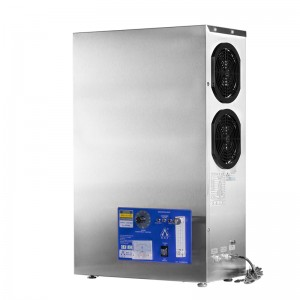As we all know, in the prevention of food, drugs, cosmetics and other health products deterioration, ozone has a very important role, can significantly extend the shelf life of food.
According to Mr. Zhou Legislative, food safety division of Shanghai Kangjiu Disinfection Technology Co., LTD., which specializes in the development of food safety and security programs, ozone can extend the shelf life of food mainly because ozone has an efficient sterilization and disinfection effect.
In addition to the bactericidal effect, ozone also eliminates indoor and outdoor odors, decomposes harmful substances, treats sewage, bleaches and so on.
Although ozone has been used in production and life for a long time, many people still do not know how ozone is generated from the ozone generator, and the circuit structure of the ozone generator is not clear.

First, the principle of ozone generation
Ozone is a strong oxidizing agent obtained by high pressure ionization (or electrolysis, chemical, photochemical reactions), which is produced by breaking down part of the oxygen in the air into oxygen atoms, which are then polymerized with oxygen molecules to form ozone.
The nature of ozone is extremely unstable, and it will decompose quickly after production, so ozone can only be produced and used. The device that produces ozone is called an ozone generator. According to the different ways of ozone generation, ozone generators are mainly divided into three types: high-voltage discharge ozone generators, electrolytic ozone generators, and ultraviolet radiation ozone generators.
Second, the circuit structure of ozone generator
The ozone generator circuit consists of a push-pull oscillator circuit composed of triode VT1, VT2 and inductor L1-13, pulse transformer T, current limiting resistor R1, charging capacitor C3, bidirectional trigger diode 5, etc. The filter inductor L0, the rectifier diode VD1 and the filter capacitors C1 and C2 constitute a half-wave rectifier filter circuit. Turn on the power supply, the AC 220V voltage is filtered by LO, and after VD1 rectification, a voltage of about ten 280V is generated at both ends of C1 to supply the push-pull oscillation circuit. At the moment of startup, the VT1 switches on. Due to the charging action of C3, the bidirectional trigger diode VD5 is cut off.
When the charging voltage at both ends of the C3 rises to 32V, the VD5 is triggered to switch on, causing the VT2 to switch on. During VT2 conduction, C3 gradually discharges, which in turn shuts off VT2. After the VTl is powered on, a positive feedback voltage is generated on L1 and L2 under the action of the pulse transformer T. The voltage is added to the base of the VTl and VT2 respectively, so that the VTl and VT2 are powered on and off alternately (that is, when the VTl is powered on, VT2 stops. When VT2 is on, VTl is off), the push-pull oscillator circuit oscillates. After the push-pull oscillation circuit is operated, a pulse high voltage is generated on the secondary side winding L6 of the pulse transformer T, which makes the ozone generator VG work and produces ozone.
At the same time, the light-emitting diode VD7 also lights up. Components Select VTl, VT2 choose 2SC2653 or BU406 silicon NPN high reverse voltage triode. Required current amplification factor β>100. VDl, VD4, VD6 choose 1 N4007 rectifier diode; VD5 uses DB3 bi-directional trigger diode. R1 and R6 all use RJ 1/8W metal film resistors. The magnetic core inductor whose L0 is 5mH can be wound 210 turns on the skeleton with a enamelled wire of Φ0.25mm. L1 is made of single-core plastic copper wire with Φ0.2mm wound on the same magnetic ring, in which L1 and L2 are wound 3 turns, respectively, and L3 is wound 9 turns. The pulse transformer T can be reformed using a 14in (inch) black and white TV line output transformer, which uses the high voltage packet as L6, uses the Φ0.45mm enamelled wire to wind 168 turns as L4 on the low voltage packet skeleton, and uses the Φ0.23mm enamelled wire to wind 4 turns as L5 (wound in the outermost layer). Ozone generation sheet VG selected Z20 10 or Z-15, Z-20 and other models.
With the exception of the ozone generating sheet VG, all electronic components are mounted on a homemade printed circuit board, which is then packed into a plastic or wooden box of suitable size. The light-emitting diode VD7 is fixed in a hole on the box surface and connected to the ozone generating sheet VG. As long as the components are good and the wiring is correct, the power can work.
Post time: Nov-05-2024


